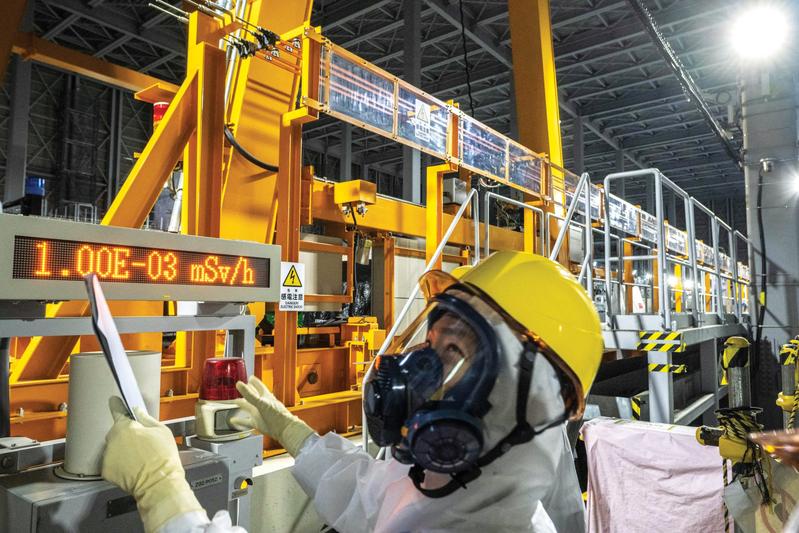Concerns remain despite Japan’s assurance that nuclear wastewater will be disposed safely
 A staff member visits the multi-nuclide removal system of the Fukushima Daiichi nuclear power plant, in Okuma, Fukushima prefecture, on Jan 20. (PHOTO / AFP)
A staff member visits the multi-nuclide removal system of the Fukushima Daiichi nuclear power plant, in Okuma, Fukushima prefecture, on Jan 20. (PHOTO / AFP)
Although Japan has deferred plans to release nuclear wastewater from the crippled Fukushima Daiichi nuclear power plant into the Pacific Ocean the question remains: will it be safe?
The wastewater is the by-product from cooling the plant’s nuclear reactors following the 2011 magnitude 9.0 earthquake and tsunami. Over one million metric tons of radioactive water is now stored in 1,000 tanks at the site.
Two years ago when Japan first announced it would release the water into the ocean it raised concerns from its neighbours, particularly Pacific Island nations that have suffered greatly from decades of United States and French nuclear testing.
At the conclusion of the Pacific Islands Forum (PIF) in Fiji on Feb 25, Pacific leaders agreed science and data must guide any future decision on wastewater disposal.
On Feb 9, the Japanese government told visiting Pacific leaders that disposing of the water into the sea was essential for the decommissioning work necessary for Fukushima’s reconstruction.
At the same time Japan said the disposal will be done “under internationally accepted approaches and in full compliance with safety standards”.
When an earthquake struck the region on March 11, 2011, it sent a 15-metre-high tsunami along the coast killings thousands and destroying the power supply used to cool the nuclear power plant’s three reactors.
For the next two years cooling seawater and, later, groundwater flowed through the destroyed reactor and was dumped directly into the Pacific Ocean.
“Those first two years were the most dangerous time because long-lived heavy nuclei like cesium-137, strontium-90, and iodine-131 ended up in the atmosphere and ocean,” said David Krofcheck, senior lecturer in physics at New Zealand’s University of Auckland.
He said the solution to reducing the number of nuclear fission nuclei released was to develop and employ in 2013 an advanced liquid processing system (ALPS).
“A series of filters was designed to remove all fission nuclei except for tritium and carbon-14. The ALPS partially worked.”
Both the Tokyo Electric Power Company and International Atomic Energy Agency agreed that around 70 percent of the stored water could contain the original nuclear fission nuclei, he added.
“This water should be run through more cycles of the ALPS before dilution and release into the ocean,” he said. “The other 30 percent of the treated water can be diluted with seawater by factors of several hundred-to-one thousand and then released into the ocean.
Professor Jamie Quinton, who heads the school of natural sciences at Massey University in New Zealand, said: “If the release of wastewater into the ocean is to proceed, getting the process correct and within regulations is of particular importance to Japan’s aquaculture-based industries.
“It is in Japan’s economic interest to ensure that the waterways remain below internationally acceptable levels for background radiation so that food safety is assured, and their capacity for international trade remains unaffected.”
Krofcheck said remaining tritium and carbon-14 from the Fukushima reactor may find its way into the food chain but they have a 10-day half-life.
Japan has said the water will be treated and released over several decades, and sees it as the only realistic solution to the waste issue.
The PIF’s outgoing chair, Fiji’s Prime Minister Sitiveni Rabuka, together with other PIF leaders, said the decision is not just a domestic issue for Japan, but concerns South Pacific island countries and beyond.
In March 2022, the PIF formed an independent panel of global experts on nuclear issues.
“The main objective of the panel is to provide independent technical advice into the ongoing dialogue with Japanese officials and the owners of the Daiichi nuclear plant,” a PIF spokesperson said.
Vanuatu stateswoman and Nuclear Free and Independent Pacific (NFIP) movement activist Motarilavoa Hilda Lini said recently: “We are people of the ocean, we must stand up and protect it.”
Advocacy group Youngsolwara Pacific likened the release to “nuclear war”, in a statement:
“How can the Japanese government, who has experienced the same brutal experiences of nuclear weapons in both Hiroshima and Nagasaki, wish to further pollute our Pacific with nuclear waste? To us, this irresponsible act of transboundary harm is just the same as waging nuclear war on us as Pacific peoples and our islands.”
Krofcheck said the Pacific has had a long association with nuclear contamination.
“France, and the United States all tested nuclear weapons in the Pacific in the years after the second world war. Their record on cleaning up is very poor,” he said, adding that benefits claims relating to radiation in the region is an “ongoing story”.


